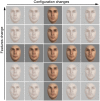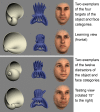Do congenital prosopagnosia and the other-race effect affect the same face recognition mechanisms?
- PMID: 25324757
- PMCID: PMC4179381
- DOI: 10.3389/fnhum.2014.00759
Do congenital prosopagnosia and the other-race effect affect the same face recognition mechanisms?
Erratum in
-
Corrigendum: Do congenital prosopagnosia and the other-race effect affect the same face recognition mechanisms?Front Hum Neurosci. 2015 May 27;9:294. doi: 10.3389/fnhum.2015.00294. eCollection 2015. Front Hum Neurosci. 2015. PMID: 26074802 Free PMC article.
Abstract
Congenital prosopagnosia (CP), an innate impairment in recognizing faces, as well as the other-race effect (ORE), a disadvantage in recognizing faces of foreign races, both affect face recognition abilities. Are the same face processing mechanisms affected in both situations? To investigate this question, we tested three groups of 21 participants: German congenital prosopagnosics, South Korean participants and German controls on three different tasks involving faces and objects. First we tested all participants on the Cambridge Face Memory Test in which they had to recognize Caucasian target faces in a 3-alternative-forced-choice task. German controls performed better than Koreans who performed better than prosopagnosics. In the second experiment, participants rated the similarity of Caucasian faces that differed parametrically in either features or second-order relations (configuration). Prosopagnosics were less sensitive to configuration changes than both other groups. In addition, while all groups were more sensitive to changes in features than in configuration, this difference was smaller in Koreans. In the third experiment, participants had to learn exemplars of artificial objects, natural objects, and faces and recognize them among distractors of the same category. Here prosopagnosics performed worse than participants in the other two groups only when they were tested on face stimuli. In sum, Koreans and prosopagnosic participants differed from German controls in different ways in all tests. This suggests that German congenital prosopagnosics perceive Caucasian faces differently than do Korean participants. Importantly, our results suggest that different processing impairments underlie the ORE and CP.
Keywords: Asian; Caucasian; congenital prosopagnosia; face recognition; other-race effect.
Figures









Similar articles
-
Face Perception and Test Reliabilities in Congenital Prosopagnosia in Seven Tests.Iperception. 2016 Jan 20;7(1):2041669515625797. doi: 10.1177/2041669515625797. eCollection 2016 Jan-Feb. Iperception. 2016. PMID: 27482369 Free PMC article.
-
Training with own-race faces can improve processing of other-race faces: evidence from developmental prosopagnosia.Neuropsychologia. 2011 Jul;49(9):2505-13. doi: 10.1016/j.neuropsychologia.2011.04.031. Epub 2011 May 6. Neuropsychologia. 2011. PMID: 21570991 Free PMC article.
-
Motion as a cue to face recognition: evidence from congenital prosopagnosia.Neuropsychologia. 2013 Apr;51(5):864-75. doi: 10.1016/j.neuropsychologia.2013.01.022. Epub 2013 Feb 4. Neuropsychologia. 2013. PMID: 23391556
-
The Cambridge Face Memory Test: results for neurologically intact individuals and an investigation of its validity using inverted face stimuli and prosopagnosic participants.Neuropsychologia. 2006;44(4):576-85. doi: 10.1016/j.neuropsychologia.2005.07.001. Epub 2005 Sep 19. Neuropsychologia. 2006. PMID: 16169565
-
[Congenital prosopagnosia: symptoms, cognition, and neural correlates].Brain Nerve. 2014 Apr;66(4):403-11. Brain Nerve. 2014. PMID: 24748088 Review. Japanese.
Cited by
-
Evidence for normal novel object recognition abilities in developmental prosopagnosia.R Soc Open Sci. 2020 Sep 23;7(9):200988. doi: 10.1098/rsos.200988. eCollection 2020 Sep. R Soc Open Sci. 2020. PMID: 33047056 Free PMC article.
-
Face Perception and Test Reliabilities in Congenital Prosopagnosia in Seven Tests.Iperception. 2016 Jan 20;7(1):2041669515625797. doi: 10.1177/2041669515625797. eCollection 2016 Jan-Feb. Iperception. 2016. PMID: 27482369 Free PMC article.
References
-
- Avidan G., Thomas C., Behrmann M. (2008). An integrative approach towards understanding the psychological and neural basis of congenital prosopagnosia, in Cortical Mechanisms of Vision, eds Jenkin M., Harris L. R. (New York, NY: Cambridge University Press; ), 241–270 Available online at: http://tdlc.ucsd.edu/research/publications/Avidan_Integrative_Approach_2... (Accessed June 19, 2014).
LinkOut - more resources
Full Text Sources
Other Literature Sources
Miscellaneous

